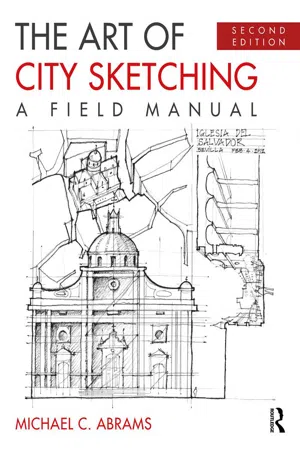
- 416 pages
- English
- ePUB (mobile friendly)
- Available on iOS & Android
About this book
The Art of City Sketching: A Field Manual guides readers through the process of freehand architectural sketching and explains orthographic, diagrammatic, three-dimensional, and perceptual-type drawings. The book presents hundreds of drawings of historic buildings and urban spaces, examples, and exercises, which help readers develop their drawing skills and employ sketching as an analytical tool. The book is divided into three parts, based on the reader's skill level: beginner, intermediate, and advanced. As an architect and field sketching instructor, the author shows that through drawing the reader can discover, analyze, and comprehend the built environment.
The new edition of The Art of City Sketching expands on the drawing techniques of the previous version by adding new drawing examples, exercises, and two new chapters—Chiaroscuro and Storyboard. New drawing tips, demonstrations, and composition "do's and don'ts" will support readers when they illustrate their viewpoint of the city by using simple drawing tools. The lessons in this book will allow readers to mix method with imagination and sensibility.
Frequently asked questions
- Essential is ideal for learners and professionals who enjoy exploring a wide range of subjects. Access the Essential Library with 800,000+ trusted titles and best-sellers across business, personal growth, and the humanities. Includes unlimited reading time and Standard Read Aloud voice.
- Complete: Perfect for advanced learners and researchers needing full, unrestricted access. Unlock 1.4M+ books across hundreds of subjects, including academic and specialized titles. The Complete Plan also includes advanced features like Premium Read Aloud and Research Assistant.
Please note we cannot support devices running on iOS 13 and Android 7 or earlier. Learn more about using the app.
Information
Part I

Analytical diagrams of the Church of San Giorgio Maggiore in Venice, Italy
Lesson 1: Elevations
Objectives

Elevation sketch of the Einstein Tower in Potsdam, Germany
Introduction: What is an elevation?

Use geometry and regulating lines to draw a face in elevation

Depiction of façades on paper
Table of contents
- Cover
- Half Title
- Title Page
- Copyright Page
- Dedication
- Contents
- About the Author
- Foreword by Andrea Ponsi
- Preface
- Acknowledgments
- Contributors
- Introduction
- Sketching Supplies
- General Drawing Tips
- Part I Beginner: Orthographic Projection
- Part II Intermediate: 3D Projection
- Part III Advanced: Perceptual Projection
- Conclusion
- Bibliography
- Index